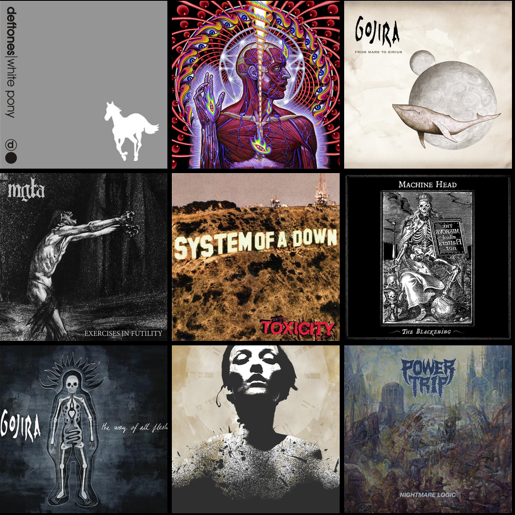The greatest metal albums of the 21st century

Record Label credits: Listenable records, Roadrunner, Volcano, Southern Lord, Maverick records
Few genres of music have inspired as much devotion or disgust as metal. Ever since Tony Iommi of Black Sabbath decided to experiment with blues-inspired guitar riffs and lots of distortion, he inadvertently created one of the most loved and hated music genres of all time. Thirty years after the group’s debut, the genre blew up and had its golden age in the 1980s. At the turn of the 21st century, metal had arguably its commercial peak in the 2000s, followed by a decline in the 2010s. That’s where this list comes in. Here, I’ve ranked the five greatest metal albums of the 21st century.
Honorable Mentions: “Iowa” by Slipknot, “The Way of All Flesh” by Gojira, and “The Blackening” by Machine Head. Exercises in futility by mgla
5. “Dopethrone” by Electric Wizard (2000)
Metal is no stranger to having projects come from a bad place in the artist’s psyche, and “Dopethrone” by English doom metal band Electric Wizard is a perfect encapsulation of that. From start to finish, the album is jam-packed with Jus Oborn’s disgusting, low-tuned, chromatic guitar sludge alongside his bleak nihilistic lyrics that were a new brand of heaviness — even by 2000s standards. The crushing riffs are paired with Tim Bagshaw’s fuzzy yet menacing bass tones, which adds to the overall uneasy feeling of the record. Any first-time listener of this album will immediately understand the Black Sabbath influences of which Electric Wizard plays to their strengths, while it avoids sounding derivative and adds a new spin to the doom metal subgenre.
4. “From Mars to Sirius” by Gojira (2005)
Who would have thought that an environmentally-themed science fiction narrative would make for a great title to a technical death metal album? The third studio album by French metal band Gojira was its breakout release as it propelled the band to stardom, and for good reason. “From Mars to Sirius” is a concept album about the long-term effects of climate change from the perspective of a narrator trying to find a new home for humans in the distant future, including the broader themes of death and rebirth. All of this is paired perfectly with incredibly tight musicianship as drummer Mario Duplantier proves on each song that he’s in contention for being the best active drummer today. Yet the peak of the album is easily it’s over seven-minute song, “Flying Whales,” which begins with an intro that drags out for longer than most people would expect, while also teasing an inevitable explosion less than a third of the way in. It has never let its foot off the pedal since.
3. “White Pony” by Deftones (2000)
Deftones’ third studio album, “White Pony,” pushed the boundaries of what alternative metal could be. Deftones abandoned its more traditional nu-metal sound to embrace a much more atmospheric and experimental tone that perfectly blended into 48 minutes of pure bliss. Deftones also pioneered the usage of samples and electronic elements in metal with this record that layered masterfully with the juxtaposition of Chino Moreno’s soft and breathy vocals with Stephen Carpenter’s menacing, down-tuned riffs. Few metal bands could change their entire sound and aesthetic while keeping the original fanbase, which inspired dozens of bands to realize it’s OK to change your formula and experiment.
2. “Lateralus” by Tool (2001)
Tool is by far the strangest band to make it to the mainstream world of rock and metal, and its album “Lateralus” showed how, because it’s amazing. It certified Tool as the standard bearer of prog rock since Pink Floyd broke up in the mid-80s. The entire record flows through as if it was a singular one-hour and 31-minute song instead of an album. For a band known for constantly challenging the norms and pushing boundaries, it completely outdid itself here. The album is chock-full of intricacies upon intricacies, most famously the inclusion of the Fibonacci sequence (math sequence which creates a spiral on a graph which represents the song also going in spirals) on the title track of the album (any interaction with a Tool fan will let you know the band will not shut up about it). The entire album runs like clockwork, with Maynard James Keenan delivering one of the best vocal performances I’ve heard in metal, on top of Danny Carey’s drumming, which switches rhythms as if it was nothing. A band like Tool has a valid reason for having such a devoted and annoying fanbase, and this record alone gives them every right to be.
1. “Toxicity” by System of a Down (2001)
Balancing the line between accessibility and creativity is one of the hardest things you can do as an artist; what is more original may alienate potential casual listeners, while going for the lowest common denominator can make you like every other band and make your core fanbase eventually turn their back on you. Los Angeles-based alternative metal band “System of a Down” walked the tightrope between the two, and it culminated in one of the most recognizable and popular albums the genre has ever seen. The album mixes old-fashioned nu-metal riffs with traditional middle eastern melodies and rhythms that paid tribute to the band’s Armenian heritage while still reaching audiences of hundreds of millions of people. However, the main strength of the album is the vocals; Serj Tankian delivers an unusual, yet incredible vocal performance throughout the album, while spitting hard-hitting lyrics about everything from the military-industrial complex and U.S. foreign policy to mindless partying and hedonism. Yet through it all, the band keeps its

Junior Felipe Castro is a reporter and this is his second year on staff. He enjoys watching old movies, writing songs and playing guitar.


